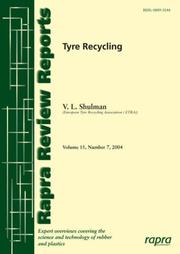| Listing 1 - 6 of 6 |
Sort by
|
Book
ISBN: 1680155024 1847356842 9781847356840 9781680155020 1847356826 9781847356826 Year: 2014 Publisher: Shropshire, England : Smithers Rapra,
Abstract | Keywords | Export | Availability | Bookmark
 Loading...
Loading...Choose an application
- Reference Manager
- EndNote
- RefWorks (Direct export to RefWorks)
The environmental and economic need to increase recycling rates is a principal driving force behind technological innovation in the 21 st century. Waste rubber products are an important resource that the global community is focusing on to achieve vital improvements in sustainability and meet important life cycle goals. . This comprehensive review, with extensive up-to-date referencing, covers all aspects of rubber recycling, from its world market to the many novel technologies and processes that have been developed to re-use the material to manufacture added-value products. . One objective of
Rubber --- Rubber, Reclaimed. --- Reclaimed rubber --- Rubber industry and trade --- Tires --- Caoutchouc --- Ebonite --- Gum elastic --- India rubber --- Vulcanite --- Latex --- Non-timber forest products --- Elastomers --- Gutta-percha --- Recycling. --- Reclaiming --- Recycling

ISBN: 1281774626 9786611774622 1847352065 9781847352064 9781859574898 9781847352064 1859574890 9781281774620 6611774629 Year: 2004 Publisher: Shrewsbury, U.K. : Rapra Technology,
Abstract | Keywords | Export | Availability | Bookmark
 Loading...
Loading...Choose an application
- Reference Manager
- EndNote
- RefWorks (Direct export to RefWorks)
This is an expert overview on the topic of tyre recycling. It summarises current practices and the factors that have contributed to their growth and efficacy as viable, economically and environmentally sound methods of dealing with post-consumer tyres. There are around 1 billion tyres produced each year across the globe. It is estimated that for every tyre sold another joins the waste stream. There are some simple options such as retreading or shipping to countries with less stringent tread requirements, but this does not solve the problem. Tyres have been identified as a priority waste stream
Rubber. --- Rubber --- Tires --- Rubber, Reclaimed. --- Reclaimed rubber --- Rubber industry and trade --- Recycling (Waste, etc.) --- Rubber, Reclaimed --- Caoutchouc --- Ebonite --- Gum elastic --- India rubber --- Vulcanite --- Latex --- Non-timber forest products --- Elastomers --- Gutta-percha --- Recycling. --- Reclaiming --- Recycling
Book
ISSN: 00653195 ISBN: 3540539409 9783540539407 0387539409 354046462X 9780387539409 Year: 1991 Volume: 101 Publisher: Berlin: Springer,
Abstract | Keywords | Export | Availability | Bookmark
 Loading...
Loading...Choose an application
- Reference Manager
- EndNote
- RefWorks (Direct export to RefWorks)
fysicochemie --- Macromolecules --- 678.041.2 --- 678.048 --- 678.028 --- Industries based on macromolecular materials. Rubber industry. Plastics industry--?.041.2 --- Anti-oxidants. Preservatives. Stabilizers --- Curing. Vulcanizing. Reclaiming. Other chemical operations during or after forming --- 678.028 Curing. Vulcanizing. Reclaiming. Other chemical operations during or after forming --- 678.048 Anti-oxidants. Preservatives. Stabilizers --- 678.041.2 Industries based on macromolecular materials. Rubber industry. Plastics industry--?.041.2

ISBN: 1282359215 9786612359217 0520933729 9780520933729 9780520251045 0520251040 9781282359215 Year: 2007 Publisher: Berkeley : University of California Press,
Abstract | Keywords | Export | Availability | Bookmark
 Loading...
Loading...Choose an application
- Reference Manager
- EndNote
- RefWorks (Direct export to RefWorks)
Written for everyone who loves and is simultaneously driven crazy by the holiday season, Christmas: A Candid History provides an enlightening, entertaining perspective on how the annual Yuletide celebration got to be what it is today. In a fascinating, concise tour through history, the book tells the story of Christmas-from its pre-Christian roots, through the birth of Jesus, to the holiday's spread across Europe into the Americas and beyond, and to its mind-boggling transformation through modern consumerism. Packed with intriguing stories, based on research into myriad sources, full of insights, the book explores the historical origins of traditions including Santa, the reindeer, gift giving, the Christmas tree, Christmas songs and movies, and more. The book also offers some provocative ideas for reclaiming the joy and meaning of this beloved, yet often frustrating, season amid the pressures of our fast-paced consumer culture. DID YOU KNOWFor three centuries Christians did not celebrate Christmas? Puritans in England and New England made Christmas observances illegal? St. Nicholas is an elf in the famous poem "The Night Before Christmas"? President Franklin Roosevelt changed the dateof Thanksgiving in order to lengthen the Christmas shopping season? Coca-Cola helped fashion Santa Claus's look in an advertising campaign?
Christmas --- History. --- biblical history. --- biographical. --- biography. --- birth of jesus. --- christmas history. --- christmas songs. --- christmas traditions. --- faith and belief. --- family. --- gift giving. --- history of christianity. --- holiday season. --- intriguing stories. --- life lessons. --- memoir. --- modern consumerism. --- pre-christian roots. --- reclaiming the joy. --- reindeer. --- santa. --- spirituality. --- story of christmas. --- tour through history. --- uplifting stories.
Book
ISBN: 128383670X 1782040471 1847010571 Year: 2012 Publisher: Woodbridge : Boydell & Brewer Ltd.,
Abstract | Keywords | Export | Availability | Bookmark
 Loading...
Loading...Choose an application
- Reference Manager
- EndNote
- RefWorks (Direct export to RefWorks)
During the last fifty years, large sums of money, huge resources of labour and vast amounts of creative energy have been invested in international theatre festivals in Africa. Under banners such as 'Reclaiming the African Past' and 'African Renaissance', the festival participants have used the performing arts to address a variety of topical issues and to confront images embedded by a century of patronising colonial expositions. The themes indicate the desire to take history by the forelock, challenge perceptions and transform communities. Volume Editor: JAMES GIBBS. Series Editors: Martin Banham, Emeritus Professor of Drama & Theatre Studies, University of Leeds; James Gibbs, Senior Visiting Research Fellow, University of the West of England; Femi Osofisan, Professor at the University of Ibadan; Jane Plastow, Professor of African Theatre, University of Leeds; Yvette Hutchison, Associate Professor, Department of Theatre & Performance Studies, University of Warwick.
African drama --- Politics and literature --- Politics in literature. --- Theater --- Dramatics --- Histrionics --- Professional theater --- Stage --- Theatre --- Performing arts --- Acting --- Actors --- Political science in literature --- Literature --- Literature and politics --- History and criticism. --- History --- Political aspects --- Festivals --- Days --- Manners and customs --- Anniversaries --- Fasts and feasts --- Pageants --- Processions --- 'African Renaissance'. --- 'Reclaiming the African Past'. --- Africa. --- African Theatre 11: Festivals. --- African theatre. --- American higher education. --- colonial expositions. --- festival participants. --- history. --- international theatre festivals. --- perceptions. --- performing arts. --- trends.
Book
ISBN: 9780262358545 0262358549 9780262538916 0262538911 0262358557 Year: 2020 Publisher: Cambridge : The MIT Press,
Abstract | Keywords | Export | Availability | Bookmark
 Loading...
Loading...Choose an application
- Reference Manager
- EndNote
- RefWorks (Direct export to RefWorks)
An examination of the process of prioritizing private motorized transportation in Bengaluru, a rapidly growing megacity of the Global South. Automobiles and their associated infrastructures, deeply embedded in Western cities, have become a rapidly growing presence in the mega-cities of the Global South. Streets, once crowded with pedestrians, pushcarts, vendors, and bicyclists, are now choked with motor vehicles, many of them private automobiles. In this book, Govind Gopakumar examines this shift, analyzing the phenomenon of automobility in Bengaluru (formerly known as Bangalore), a rapidly growing city of about ten million people in southern India. He finds that the advent of automobility in Bengaluru has privileged the mobility needs of the elite while marginalizing those of the rest of the population. Gopakumar connects Bengaluru's burgeoning automobility to the city's history and to the spatial, technological, and social interventions of a variety of urban actors. Automobility becomes a juggernaut, threatening to reorder the city to enhance automotive travel. He discusses the evolution of congestion and urban change in Bengaluru; the "regimes of congestion" that emerge to address the issue; an "infrastructurescape" that shapes the mobile behavior of all residents but is largely governed by the privileged; and the enfranchisement of an "automotive citizenship" (and the disenfranchisement of non-automobile-using publics). Gopakumar also finds that automobility in Bengaluru faces ongoing challenges from such diverse sources as waste flows, popular religiosity, and political leadership. These challenges, however, introduce messiness without upsetting automobility. He therefore calls for efforts to displace automobility that are grounded in reordering the mobility regime, relandscaping the city and its infrastructures, and reclaiming streets for other uses.
Transportation, Automotive --- Automobiles --- Traffic congestion --- Social aspects --- History. --- Congested traffic --- Congestion, Traffic --- Gridlock (Traffic flow) --- Jams, Traffic --- Reduction of traffic congestion --- Traffic jams --- Traffic flow --- Autos (Automobiles) --- Cars (Automobiles) --- Gasoline automobiles --- Motorcars (Automobiles) --- Motor vehicles --- Automotive transportation --- Highway transportation --- Motor carriers --- Motor transportation --- Road transportation --- Transportation --- Bengaluru --- Bangalore --- India --- streets --- mobility --- justice --- urban --- congestion --- politics --- technopolitical --- constellation --- regime --- infrastructurescape --- citizenship --- shabby automobility --- performativity --- affordance --- Global South --- case study --- twenty-first century --- history --- longue durée --- motorization --- cars --- transport --- roads --- cities --- environment --- infrastructure --- traffic --- cityscape --- landscape --- Karnataka --- Mysore kingdom --- South Asia --- Asia --- vehicles --- scapes --- messy --- dystopia --- instrumentality --- discourse --- privilege --- power --- disenfranchising --- unlocking --- reclaiming --- colonialism --- post-colonial --- affordability --- Urban transportation policy --- City planning --- Sustainable urban development --- Environmentally sustainable urban development --- Sustainable development --- Cities and towns --- Civic planning --- Land use, Urban --- Model cities --- Redevelopment, Urban --- Slum clearance --- Town planning --- Urban design --- Urban development --- Urban planning --- Land use --- Planning --- Art, Municipal --- Civic improvement --- Regional planning --- Urban policy --- Urban renewal --- State and urban transportation --- Urban transportation --- Urban transportation and state --- Transportation and state --- Government policy --- Management
| Listing 1 - 6 of 6 |
Sort by
|

 Search
Search Feedback
Feedback About UniCat
About UniCat  Help
Help News
News